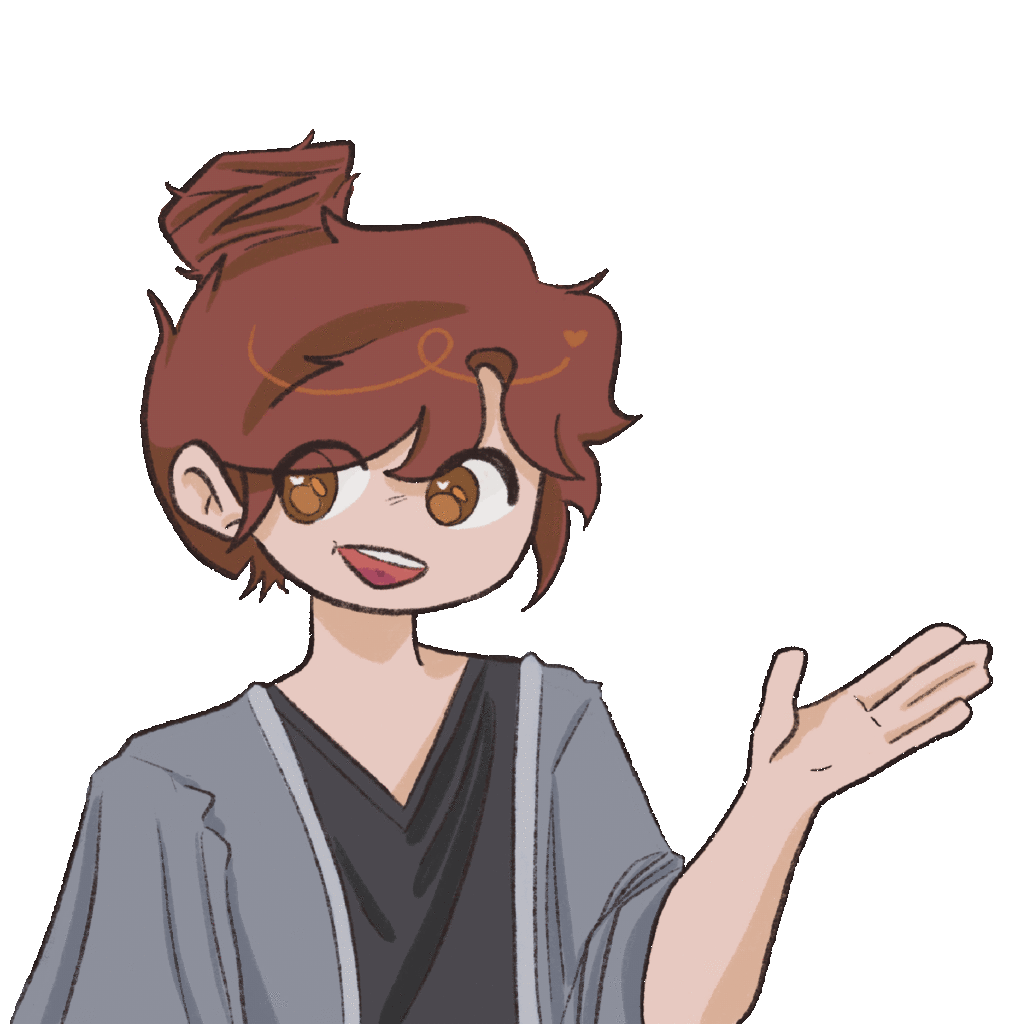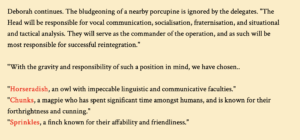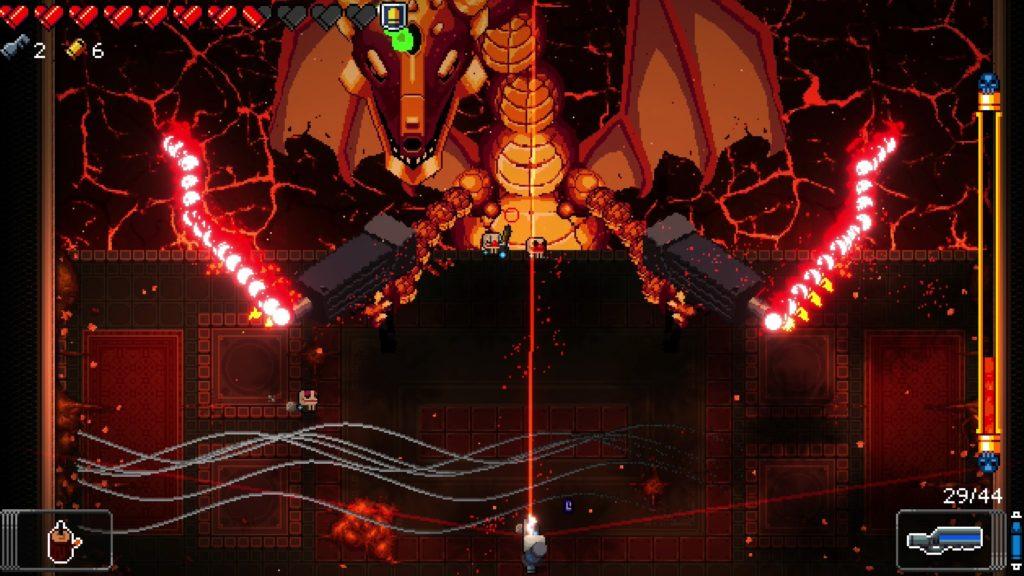Game Design as Narrative Structure
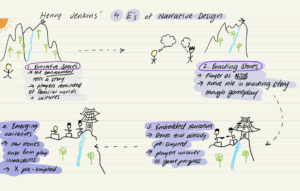
Animalia
Link: Animalia by Ian Michael Waddell
Platform: Twine (Choice-based)
(Competition): 2018 IF Competition, 3rd place
For this assignment, I played the IF game Animalia, which was created by Ian Michael Waddell. It follows the story of four animals disguised in a trench coat pretending to be a young child whom they have kidnapped for a ritual sacrifice. I played until the point where the animals encountered the child’s family and were on their way to school, reaching the part where inter-character dialogue began to emerge. At that point in the game, the player has the agency to make certain narrative decisions, such as choosing which animal to play as or which rooms to explore.
Relating to The Four E’s
Evocative Spaces:
The animal kingdom in Animalia mirrors the real-world human one. The animals have a council—though headed by authoritarian leaders—practice rituals, and also delegate responsibilities. This reminded me of many existing political systems, particularly those ruled by despotic figures, which made the setting strikingly familiar. It contributed to the game’s aesthetics by grounding these fantastical elements in recognizable social structures and power dynamics. The real-world scenes, such as interactions with an anxious mother and an unimpressed father, further reinforced this sense of realism. Altogether, these design choices fostered a strong emotional connection that I as the player could relate to, especially with the characters and the environment on a personal level.
Enacting Stories:
This mechanic took some time to become apparent and meaningful to me. Initially, the narrative offered limited player choice—there was only one option to continue the story. However, as the game progressed, players were given greater agency, such as choosing which animals would wear the replica and suit, and thus changing the narratives depending on the choices. This shift allowed for a more active role in shaping the narrative. The variety of choices available created a sense of autonomy and personal pacing, which gave me the feeling that I was co-authoring and acting out the experience as I moved past the stage of following a script.
(players given choices when choosing who to take on the responsibility on being in the replica)
Embedded Narratives:
For me, the embedded narrative elements served as a structure to the experience. Having a clear contextual framework of the game’s main premise helped me navigate the story much more effectively and pushed me to engage in more meaningful interactions. These pre-scripted components—such as dialogue and worldbuilding—really anchored my understanding and made the exploratory aspects of the game more coherent as a whole.
Emergent Narratives:
At the point where I stopped playing, I hadn’t yet reached a stage where my choices generated entirely new plotlines beyond those already presented. While I was able to select among existing paths and choices, I had not yet contributed much to designing my own narrative trajectory.
Subgenre and Narrative Affordances
Animalia is a choice-based, choose your own adventure game. Personally, I think this subgenre grants players narrative agency and the ability to shape their own experiences through these branching decisions. The primary affordance here is creative control. Players can explore different narrative paths at their own pace, which helps when engaging deeply with the story’s aesthetics and emotional tone. I definitely felt that through this subgenre structure, which emphasizes the dynamic between choice and consequence, I felt more immersed and encouraged to have more self-expression.
Inspirations and Criticisms for Future Narrative Design
Inspirations:
One of the most inspiring aspects of Animalia was its visual design. Despite its simplicity in text, the game used background colors to convey moods and settings and contexts. For instance, brown for scenes inside the trench coat, beige for the Animalia kingdom, and blue for interactions with the human family. With these visual cues, the designers sets the the evocative space up quite well to help players situate themselves within different contexts. Another inspiring feature I felt was the variation in narrative presentation. Early sections resembled more formal proses—which seem more appropriate for the council meeting—while later sections adopted a more play-like/playwriting dialogue format when the animals interacted with the human parents. To me, this stylistic shift helped differentiate settings and characters and helped players recognize and set the tone and atmosphere of the game.
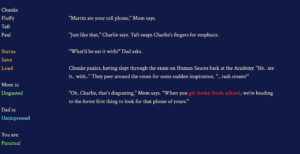
(shift to blue background when dialogue switches to human world)
Criticisms:
If I were to critique or expand upon the design, I would recommend adding sound effects to strengthen immersion. For example, a knock on the door or birds chirping during council debates would help enhance and bring out the mood of the evocative space. Even subtle auditory cues would really help to enhance the emotional texture of each scene. I also found it somewhat unclear what my specific purpose as a player was. While narrative games do often embrace ambiguity, I think having a clearer sense of my goal (e.g., whether to deceive the parents about their kid being kidnapped or tell the truth) would have deepened my engagement and made me more emotionally invested too.
Empathy and Emotional Impact
The game appears to draw empathy toward the oppressed living under authoritarian rule. I felt this especially in the beginning of the game, as the designer was still setting up the Animalia kingdom, where dissenting voices from an animal were silenced through executions. By giving those oppressed animals voices within the narrative, especially the ones within the replica, it made me feel sympathy and a bit of discomfort too for their struggles. Overall, the game evoked a mix of fascination, discomfort, and empathy from me, and with its blend of dark humor and political allegory, Animalia encouraged me as a player to reflect more on the systems of power that exist in our real world while still being humored by the imaginative absurdity of the narrative.
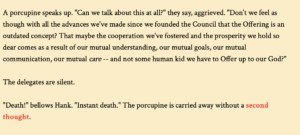
(the harsh reality of the oppressed living under authoritarian leadership)

